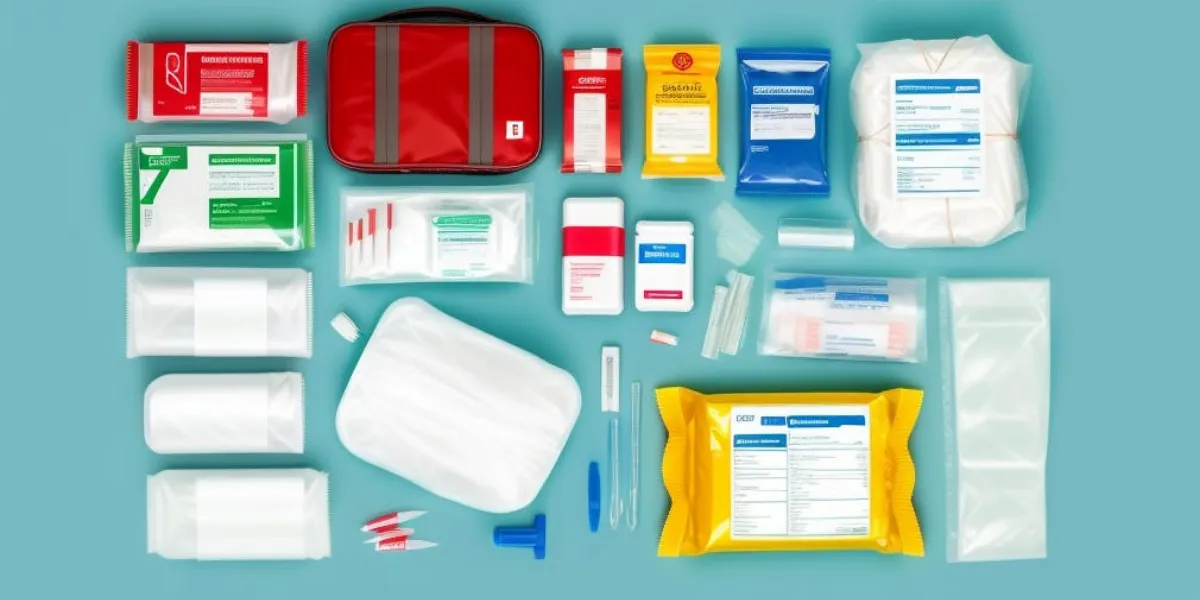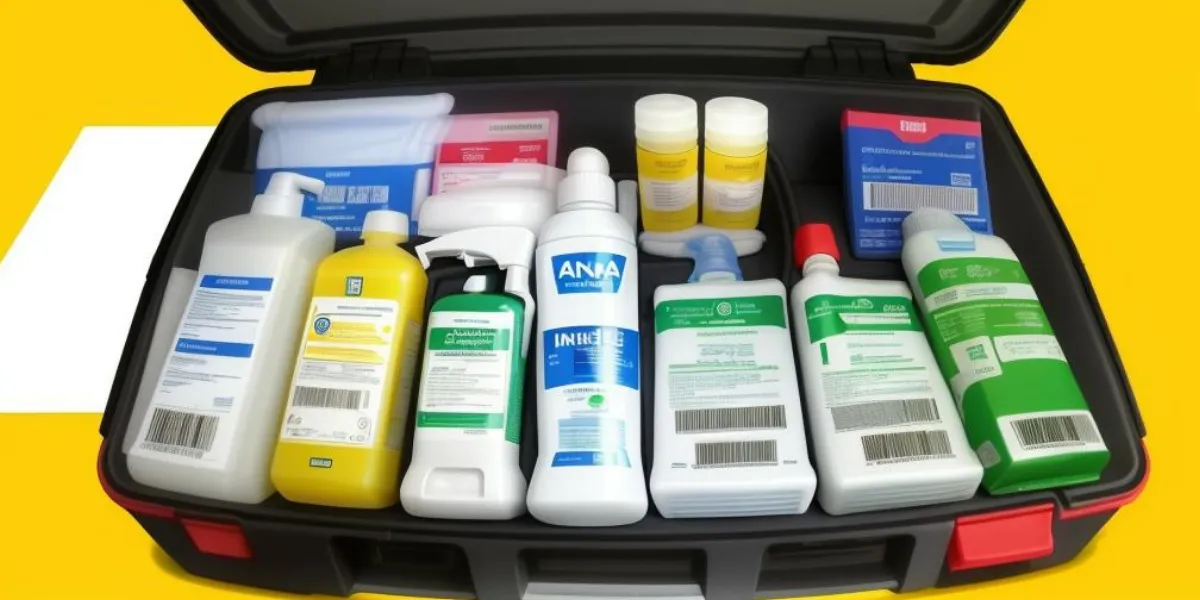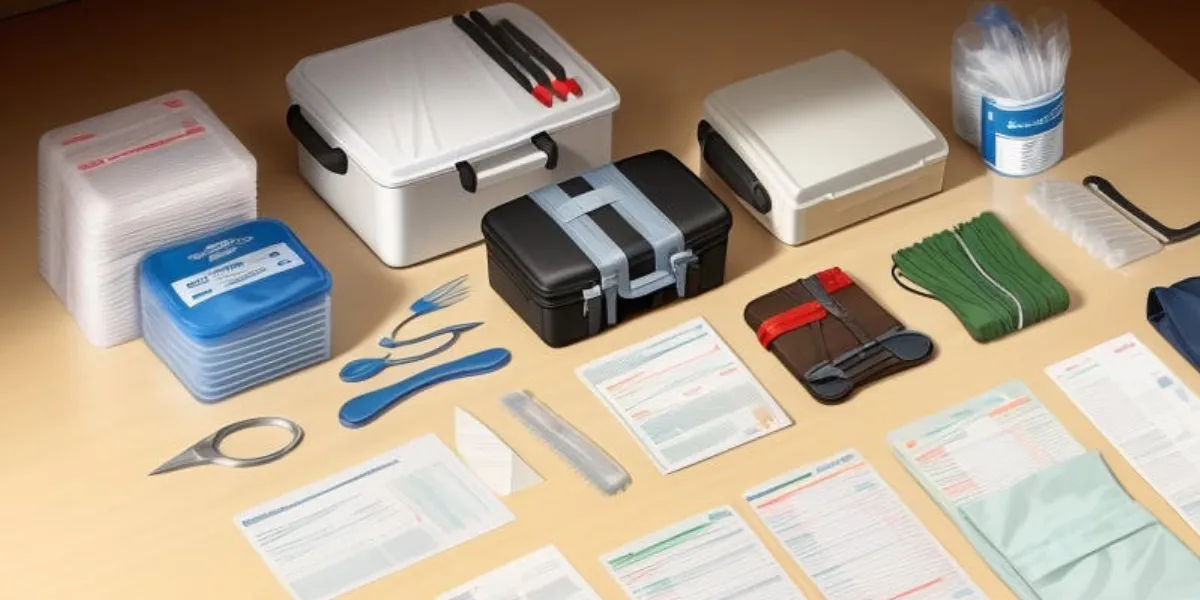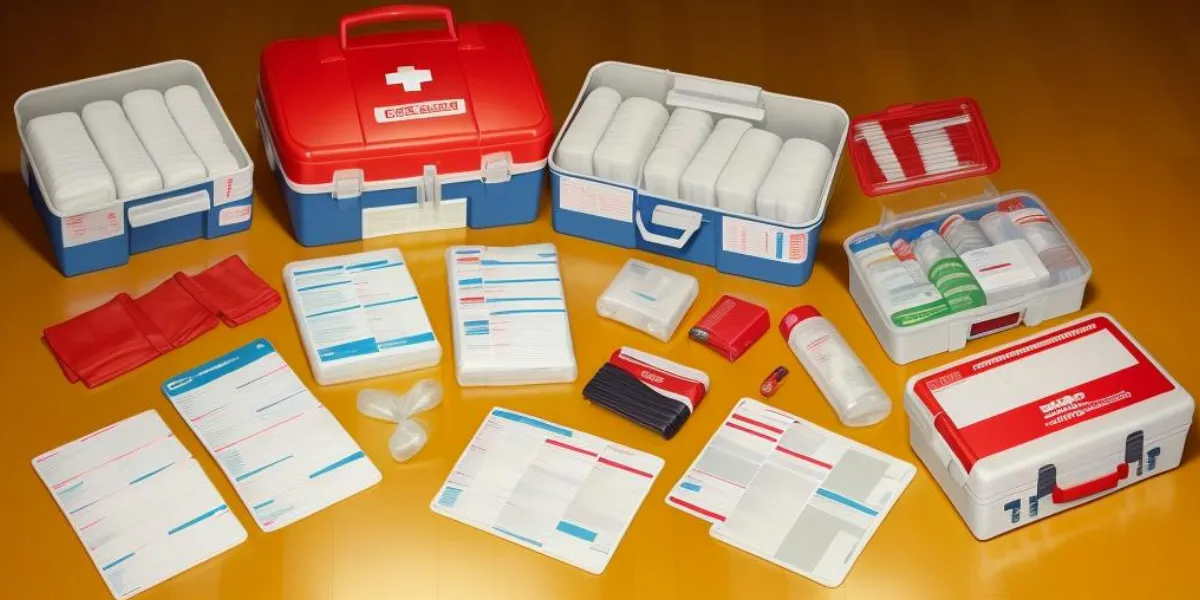
First Aid Basics: Key Supplies For Crisis Situations
Are you prepared for a crisis situation? In times of emergency, having the right supplies can make all the difference. From bandages and antiseptics to splints and emergency medical equipment, this article will guide you through the key supplies you need to have on hand. Stay informed and empowered with this concise and informative guide to first aid basics. Don’t wait until it’s too late – be ready to take action and protect yourself and others.
Key Summaries
Wound care supplies such as bandages, dressings, tourniquets, antiseptic solutions, and disinfectants are essential for preventing infection and promoting healing in crisis situations.
Proper storage and expiration date checks for medications are important to ensure their effectiveness in providing pain relief during emergencies.
Splints and braces should be available to stabilize broken bones or sprained joints, and proper application techniques should be followed for comfort and effectiveness.
First aid tools and instruments like scissors, tweezers, thermometers, stethoscopes, and blood pressure monitors are necessary for assessing and treating injuries in crisis situations.
Bandages And Dressings: A Survivalist's Must-Have
In the harsh wilderness, where crisis situations are an everyday reality, having bandages and dressings at your fingertips can mean the difference between life and death. These essential supplies are the key to providing advanced wound care and effectively managing injuries in the wild.
Out in the wild, bandages are our lifeline. They offer the support and protection we need to keep going. They control bleeding, ward off infection, and promote healing. We survivalists rely on a range of bandages, from trusty adhesive ones for minor cuts and scrapes to sturdy gauze rolls for those larger, more demanding wounds. And let's not forget the versatile triangular bandages - they're our go-to for crafting slings or securing dressings in place.
But bandages alone aren't enough. Dressings are just as crucial for us out there. They shield wounds from bacteria and dirt, creating a protective barrier that's essential in our rugged environment. The severity of the injury determines whether we use sterile or non-sterile dressings. When faced with deep or open wounds, the sterile option is preferred to minimize the risk of infection. For minor wounds and abrasions, non-sterile dressings do the trick just fine.
And let's not overlook the importance of mastering tourniquet application. As survivalists, we understand that in extreme emergencies, severe bleeding can be a potential killer. That's why we equip ourselves with the knowledge and skills to apply a tourniquet effectively. This life-saving device stops the blood flow in critical situations, especially when faced with severe trauma or arterial bleeding.
In the wild, bandages, dressings, and tourniquets are our lifelines. They empower us to navigate through the unpredictable and unforgiving wilderness. With these tools in our arsenal, they prepare us to face any crisis head-on, knowing that survival depends on our resourcefulness and the right supplies at our disposal.
Antiseptics And Disinfectants: A Survivalist's Perspective
In the wild, being prepared for crisis situations means having antiseptics and disinfectants to ensure proper wound care and prevent infections. These solutions are crucial for a survivalist in promoting healing and minimizing complications when dealing with injuries.
Hydrogen peroxide is a go-to antiseptic. Its bacteria-killing properties and ability to remove debris from wounds make it invaluable. To use it, pour a small amount onto a clean cloth or cotton ball and gently dab the wound, ensuring thorough cleanliness.
Another indispensable powerful antiseptic is povidone-iodine. This gem can eliminate a wide range of microorganisms. Diluting it with water, as the bottle instructs, will clean the wound effectively.
Apart from antiseptic solutions, we also make use of disinfectants like alcohol wipes or sprays to sanitize the area surrounding the wound. These play a vital role in killing bacteria and preventing the dreaded infection from spreading.
But remember, as a survivalist, always prioritize thorough wound cleansing before applying any antiseptics or disinfectants. Clean water and mild soap help us gently wash the area, removing dirt and debris. Before applying the antiseptic solution, ensure the wound is dry, patting it with a clean cloth or sterile gauze.

Medications And Pain Relievers
In the wild, managing pain and discomfort is crucial for well-being. It's essential to have medications and pain relievers at the ready.
When it comes to storing medications, it's important to keep them in a cool, dry place and away from direct sunlight. Regularly check the expiration dates and discard any expired medications.
Having a variety of pain relievers on hand is also important. Stock up on acetaminophen, ibuprofen, and aspirin; different individuals may respond better to different medications. Though of course use medications under proper guidance, especially if you have pre-existing medical conditions or allergies.
In the wild, you can't always rely solely on medications. You should consider alternative pain relief methods such as willow bark; it contains salicin, a compound similar to aspirin. You can chew on willow bark to alleviate pain.
Many wild plants have medicinal properties. For instance, you can use the leaves of yarrow as a natural pain reliever. Learn about local plants and their traditional uses before heading into the wild. Practice relaxation techniques like deep breathing and meditation to alleviate discomfort. Topical creams or ointments can also be used if you have any for additional relief when needed.
Splints And Braces
In the wild it is crucial to know how to properly immobilize and support injured limbs using splints and braces.
Splints are a lifeline in the wild, as they provide stability and prevent further damage to broken bones or sprained joints. When applying a splint, it is essential to follow these techniques for proper application:
Select the right size and type of splint for the injury, considering the resources available in the wilderness.
Gently straighten the limb and secure it in place using the splint, ensuring it is snug but not too tight.
Utilize padding to cushion the injured area, reducing discomfort and promoting effective healing.
On the other hand, braces are a survivalist's best friend when it comes to supporting and protecting specific body parts, such as knees, ankles, or wrists. They play a vital role in preventing further injuries and aiding in the healing process.
Here are some types of braces commonly used by survivalists for different injuries:
Knee braces: These are indispensable in providing stability and support for knee injuries, including ligament tears or strains that may occur during challenging outdoor activities.
Ankle braces: The wilderness terrain can be treacherous, making ankle sprains a common occurrence. Ankle braces are invaluable in preventing sprains or providing support during the healing process, ensuring you can keep moving.
Wrist braces: In the wild, fractures or sprains in the wrist can severely hinder survival efforts. Wrist braces offer the necessary immobilization and support needed to overcome such injuries, allowing you to continue navigating and performing essential tasks.
Remember, being able to properly utilize splints and braces can mean the difference between overcoming injuries and being immobilized. So, equip yourself with the knowledge and resources to provide essential care for your limbs in the wild.

First Aid Tools And Instruments For The Wild Survivalist
In the rugged wilderness, being prepared with the right tools and instruments is essential for providing first aid in life-or-death situations. These crucial items can mean the difference between survival and disaster, allowing you to effectively navigate through challenging circumstances.
For a survivalist living off the grid, tools like scissors, tweezers, and forceps are indispensable. They are not only useful for cutting bandages but also for removing stubborn thorns, splinters, or other foreign objects that can cause infection. A reliable thermometer becomes a lifeline, enabling you to monitor body temperature closely and identify potential fever or hypothermia risks. And with a stethoscope, you can listen attentively to the beating heart and struggling lungs, gaining critical insights into the patient's condition. Furthermore, a precise blood pressure monitor becomes a vital tool in accurately assessing health.
In the wild, where darkness can be your constant companion, a flashlight becomes an invaluable asset for examining wounds in low-light conditions. A penlight becomes a trusted ally when checking the dilation of pupils, revealing vital clues about potential head injuries.
Disposable gloves and face masks are not just for medical professionals; they are essential for a first aid kit, protecting both the patient and themselves from potential infections. And we cannot forget the importance of adhesive bandages, sterile gauze pads, and medical tape in ensuring proper wound care amidst the challenges of the wilderness.
As a survivalist, your ability to provide prompt and effective care in crisis situations relies on having these first aid tools and instruments readily available. They become an extension of your survival skills, enabling you to navigate through the unpredictable and harsh realities of the wild with confidence and resilience.
Emergency Medical Equipment
Ensure you have essential emergency medical equipment readily available in crisis situations. As a survivalist living in the wild, being prepared for emergencies is crucial. Having the right tools can mean the difference between life and death.
Here are three key items that every survivalist should have in their emergency medical kit:
One essential item to have in your emergency medical kit is a first aid kit. This should include bandages, gauze pads, adhesive tape, antiseptic wipes, and scissors; everything we have talked about above. These supplies can be used to treat minor injuries such as cuts, scrapes, and burns. Additionally, a first aid kit should also include basic medications such as pain relievers, antihistamines, and antacids to provide relief from common ailments.
Another important item to have in your emergency medical kit is a tourniquet. In the event of a severe injury that causes profuse bleeding, a tourniquet can be used to stop the bleeding and potentially save a life. It is important to learn how to properly apply a tourniquet and when to use it, as improper use can lead to further complications.
Lastly, a survivalist's emergency medical kit should include a CPR mask. In a situation where someone is in cardiac arrest, performing cardiopulmonary resuscitation (CPR) can be life-saving. However, due to the risk of infectious diseases, it is safer to use a CPR mask to provide a barrier between the two. This allows for effective rescue breaths while minimizing the risk of transmission.
In addition to these key items, it is important for survivalists to regularly check and replace expired supplies in their emergency medical kits. It is also beneficial to learn basic first aid and emergency medical techniques to be better prepared for any situation that may arise in the wild. Being equipped with the right tools and knowledge can significantly increase your chances of survival and provide peace of mind in times of crisis.

Personal Protective Gear
As a survivalist living in the wild, my gear is my lifeline, and I rely on it to keep me safe in nature's unpredictable embrace.
Layered Clothing: The wild doesn't care about your comfort, so I dress smartly. It's all about layers, designed to adapt to the ever-changing weather. My base layer wicks away moisture, the mid-layers insulate me, and my waterproof outer shell shields me from the elements.
Headgear: In the wild, it's all about being prepared. I've got my wide-brimmed hat, guarding me against the relentless sun and sudden downpours. And when the cold creeps in, a trusty warm hat is ready to keep my noggin snug.
Footwear: The right boots are a survivalist's best friend. Mine are sturdy, waterproof, and chosen to match the terrain I navigate. Gaiters? They're the unsung heroes, keeping debris and water from sneaking into my boots.
Hand Protection: A survivalist's hands are their most important tools. I've got gloves tailored to the environment and the tasks at hand. Leather work gloves for tough jobs and waterproof gloves when the elements turn against me.
Hearing Protection: The wild can be a noisy place, but I'm prepared. My safety harness and ropes are at the ready for those daring climbs or the heights of construction. And a sturdy helmet sits atop my head, guarding it from unforeseen dangers, whether I'm scaling rocks or building shelter.
Rain Gear: Rain can be a game-changer in the wild, but I won't let it get the best of me. I've got a waterproof rain jacket and pants, ensuring I stay dry and capable, no matter the downpour.
Wildlife Protection: The wild is full of surprises, some of them with teeth and claws. That's why I've got bear spray and other deterrents specific to the local wildlife. It's not just survival; it's about respecting and coexisting with the creatures that share my wild home.
Respiratory Protection: Every breath counts in the wilderness. I'm equipped with the right gear to filter out contaminants or particles that might threaten my health or well-being. My respiratory protection ensures I can breathe easy, no matter the challenges the wild throws my way.

Burn And Wound Care Supplies
As a survivalist living in the wild, it is crucial to have a well-stocked emergency kit for burn and wound care. Unforeseen burns and wounds can occur at any moment, but with the right supplies, we can prevent infection and aid in healing.
Here are three essential items that every survivalist should include in their kit:
Hydrogel dressings: These innovative dressings not only provide a cooling effect but also soothe burns by creating a moist environment that promotes healing. In our rugged lifestyle, where medical help may be far away, these dressings are vital in reducing pain and protecting the wound from further damage.
Sterile saline solution: When living in the wild, preventing infection becomes paramount. Cleaning wounds with sterile saline solution is our best defense. This gentle solution flushes out debris and bacteria from the wound, allowing for faster healing. Having a good supply of sterile saline solution ensures we can effectively cleanse wounds and keep them safe from infection.
Adhesive bandages: In our survivalist journey, small cuts and abrasions are bound to happen. That's where adhesive bandages come in. These versatile bandages are essential for covering these wounds, protecting them from dirt, bacteria, and friction. By using adhesive bandages, we allow the wounds to heal undisturbed, ensuring a quicker recovery. With various sizes and shapes available, we can accommodate different types of wounds we may encounter in the wild.
As a survivalist in the wilderness, it's essential to know how to care for burns and wounds using natural remedies when access to modern medical supplies is limited. Here are some natural burn and wound care remedies you can use:
Clean Water: The first step in caring for any wound is to clean it thoroughly. If you have access to clean water, use it to rinse the wound or burn. Use a mild soap or an antiseptic solution if available. Keep the wound as clean as possible to prevent infection.
Honey: Honey has natural antibacterial properties and can be applied to wounds and burns. It helps keep the wound clean and may promote faster healing. Use raw, unprocessed honey if possible.
Aloe Vera: Aloe vera is well-known for its soothing properties. If you have an aloe vera plant, cut a leaf and apply the gel to burns and minor wounds. Aloe vera can help relieve pain, reduce inflammation, and promote healing.
Tea Bags: Cold tea bags, especially those containing tannic acid (like black tea), can be applied to burns to relieve pain and reduce inflammation. Simply brew a cup of tea, let the bag cool, and place it on the affected area.
Plantain Leaves: Plantain leaves (not the banana-like fruit) have natural antibacterial properties. Crush the leaves to release their juices and apply them to wounds and burns. They can help soothe and protect the affected area.
Potato Slices: For minor burns, place thin potato slices directly on the affected area. Potatoes can help draw out heat and reduce pain.
Comfrey: Comfrey leaves can be used to create a poultice that promotes wound healing. Crush the leaves and apply them to the wound, but be cautious with deep wounds as comfrey should not be used on them.
Witch Hazel: Witch hazel is an astringent and anti-inflammatory agent that can help with minor burns and wounds. Apply it to the affected area with a clean cloth.
Remember that while these natural remedies can be beneficial in the wild, they are not a substitute for proper medical care. If a wound or burn is severe, deep, infected, or covers a large area, seek professional medical attention as soon as possible. Proper wound care is crucial for preventing infection and promoting healing.
Emergency Communication Devices
To effectively communicate and seek assistance during crisis situations, it is essential to have access to reliable emergency communication devices. These devices play a crucial role in connecting individuals in need with emergency responders and providing critical updates during emergencies. Here are three types of emergency communication devices that you should consider having:
| Device | Description | Key Features |
|---|---|---|
| Cell Phones | Portable phones that allow voice and text communication. | Wide network coverage, GPS capabilities, long battery life. |
| Two-Way Radios | Handheld radios that enable immediate communication within a limited range. | Instant push-to-talk communication, durable design, extended battery life. |
| Satellite Phones | Phones that use satellites to establish communication in remote areas. | Global coverage, independent of cellular networks, reliable in emergencies. |
Frequently Asked Questions
What is first aid?
First aid refers to the immediate care given to an injured or ill person before medical help arrives. It involves providing basic medical treatment to stabilize the person's condition and prevent further harm.
Why is it important to learn first aid basics?
Learning first aid is important because it equips you with the necessary skills and knowledge to respond effectively in emergency situations. It can mean the difference between life and death for the injured person.
What are the basic first aid steps?
The basic first aid steps include assessing the situation, checking for any dangers, calling emergency services, providing CPR if necessary, controlling bleeding, and providing comfort and reassurance to the injured person until help arrives.
What is CPR?
CPR stands for cardiopulmonary resuscitation. It is a life-saving technique used to restore breathing and circulation in a person who is experiencing cardiac arrest or respiratory failure.
How do I perform CPR?
To perform CPR, start by checking if the person is responsive and breathing. If they are unresponsive and not breathing, begin by giving chest compressions at a rate of 100-120 compressions per minute. After 30 compressions, give two rescue breaths. Repeat the cycle until emergency services arrive.
What should I include in a first aid kit?
A basic first aid kit should include items such as adhesive bandages, sterile gauze pads, adhesive tape, antiseptic wipes, scissors, tweezers, disposable gloves, and a first aid manual. Customize your kit according to your specific needs and activities.
How do I help someone who is choking?
If someone is choking and unable to speak, cough, or breathe, you should perform abdominal thrusts (also known as the Heimlich maneuver). Stand behind the person, place your hands above their navel, and give firm upward thrusts until the object causing the choking is dislodged.
What should I do if someone has a bleeding injury?
If someone has a bleeding injury, apply direct pressure to the wound with a clean cloth or your hand. Elevate the injured limb if possible and maintain pressure until medical help arrives. Do not remove any objects that may be stuck in the wound.
How can I learn first aid?
You can learn first aid by taking a first aid course offered by organizations like the Red Cross or other reputable providers. These courses cover essential first aid techniques and provide hands-on training to help you gain confidence in responding to emergencies.
What are some common accidents and emergencies where first aid is needed?
Common accidents and emergencies where first aid is needed include burns and scalds, fractures, deep cuts, choking, cardiac arrest, allergic reactions, poisoning, and severe bleeding. Being prepared and knowing how to respond can make a significant difference in the outcome for the injured person.
Conclusion
In times of crisis, having the right supplies can make all the difference. From bandages and antiseptics to medications and emergency medical equipment, being prepared can help you provide effective first aid. Remember the wise words of Benjamin Franklin: ‘An ounce of prevention is worth a pound of cure.’ So, stock up on these essential items, be well-equipped, and stay ready to handle any emergency that comes your way. Stay safe and be prepared!

